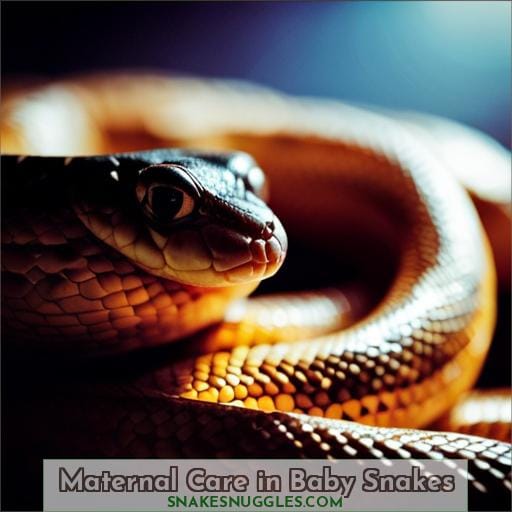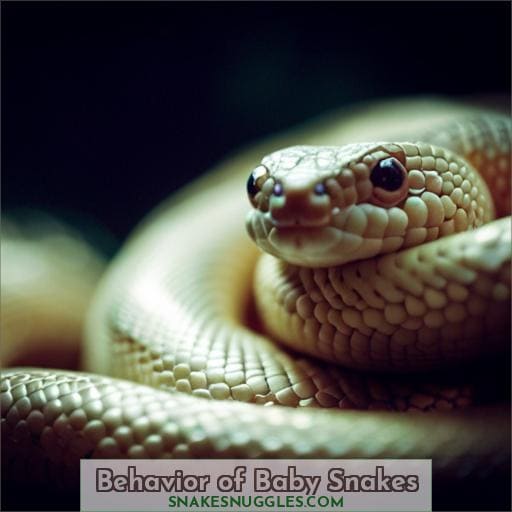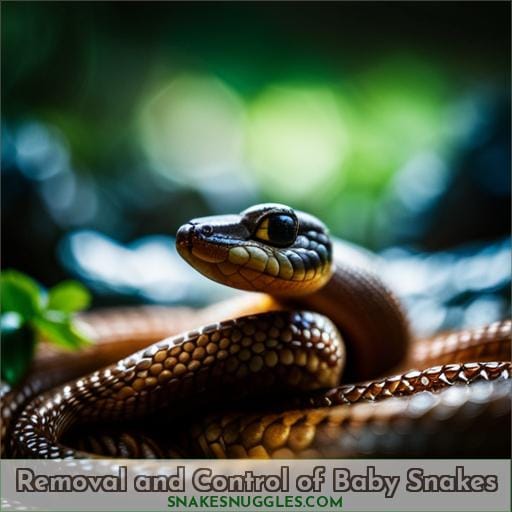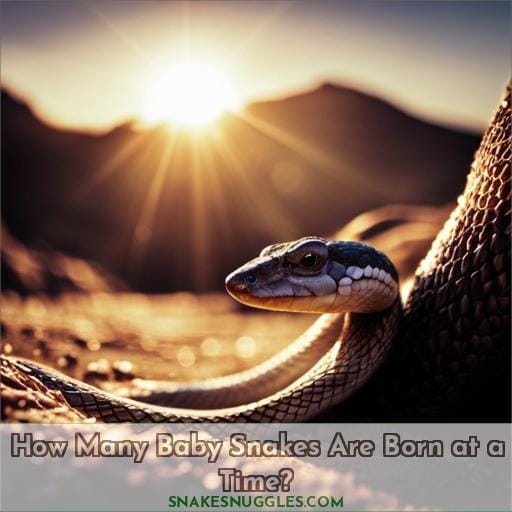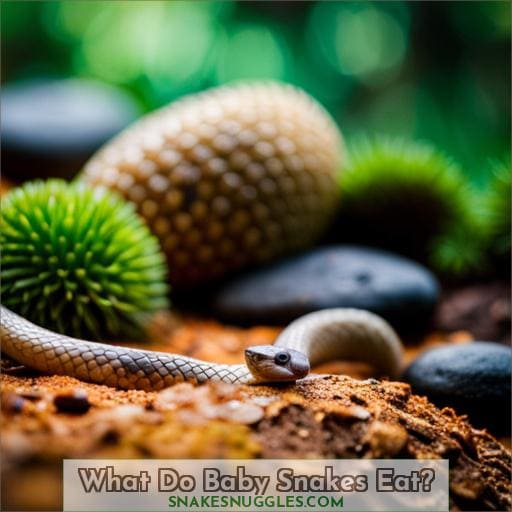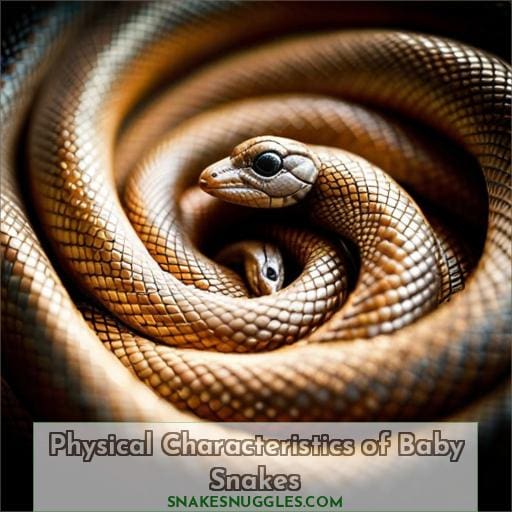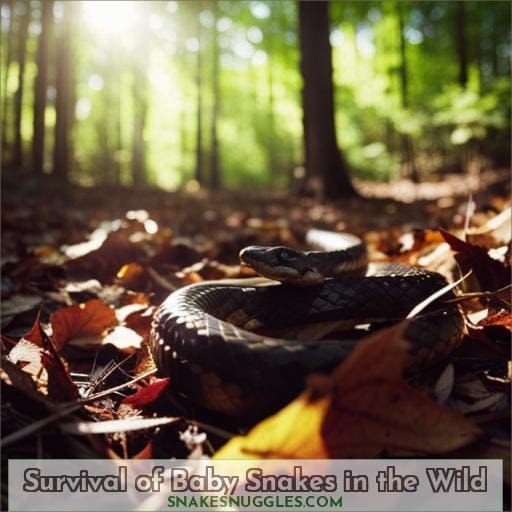This site is supported by our readers. We may earn a commission, at no cost to you, if you purchase through links.
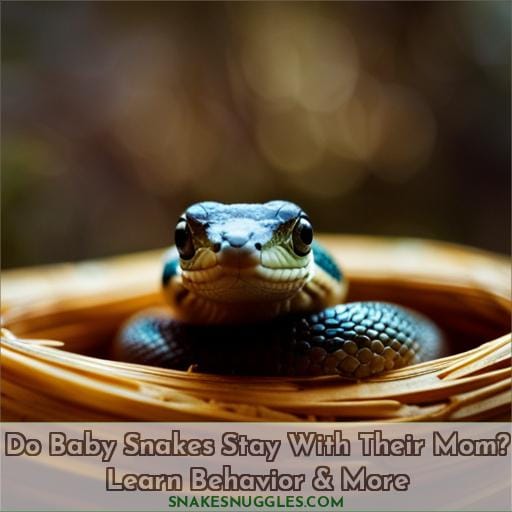
In this article, we’ll look at maternal care in different types of snakes as well as unique reproductive strategies, dietary habits, physical characteristics, and more so you can gain insight into the fascinating world of these animals.
Table Of Contents
Key Takeaways
- Baby snakes exhibit various maternal care behaviors depending on the species.
- Maternal bonding behaviors typically last for up to two weeks after birth or hatching.
- Baby snakes possess venom potency similar to adults and require frequent feeding.
- Caution should be exercised when dealing with baby snakes due to their potential venomousness.
Maternal Care in Baby Snakes
You may have heard about precocial snakes, such as King Cobras and Sea Snakes, that show some degree of maternal care for their young.
Precocial Snakes
You may be surprised to learn that some baby snakes are precocial, meaning they can take care of themselves right after birth – even before hatching from their eggs. African rock pythons protect their young for about two weeks after emergence. Vipers like rattlesnakes defend live-born neonates for up to two weeks.
Garter snakes provide companionship, and King cobras build nests for eggs and guard them. These juveniles have the same venom potency as adults, yet they require more frequent feeding due to fast growth rates.
Shedding often aids this process too! Other species like spine-bellied sea snakes have nurseries where babies find protection from predators but remain self-sufficient regarding diet and behavior in most cases.
King Cobras
Experience the remarkable maternal care of King Cobras and witness the bond between mother and young. The reptile species builds nests to protect their clutch size, offering diet variation for snake young such as insects, lizards, and eggs.
Venom potency in newborns is similar to adults – king cobra mothers defend their offspring with striking movements against predators.
Maternal bonding behaviors are exhibited with nest protection up until two weeks after birth or hatching; a rare quality among snakes that stands out amongst other reptiles’ reproductive strategies.
Witness these noble creatures’ unique behavior within safe boundaries – understanding this ancient life form brings safety and freedom from fear of being near these powerful animals when encountered outdoors in natural habitats around the world!
Sea Snakes
Gliding through the ocean’s depths, sea snakes, like spine-bellied ones, provide a sense of security to their young, like a warm blanket. Sea snakes are oviparous and have unique survival strategies compared to other snake species.
Venom potency is similar to adults, while they possess precocial nature and require frequent feeding due to their growth rate. Nest building for eggs is common among some sea snake species. They also exhibit maternal care by providing companionship for a few hours or days after birth.
Live-bearing snakes may even carry babies until birth in order for them to be self-sufficient from hatching or delivery day onward without any further interaction with mothersnakes needed.
How Long Do Snakes Stay With Their Babies?
Witnessing the complex behavior of a mother snake caring for her young is an awe-inspiring sight. Venomous snakes like rattlesnakes defend their neonates for two weeks, and garter snakes provide companionship until birth.
Python mothers guard eggs or newly hatched babies, while some sea snake species have nurseries that provide food and protection to their offspring.
However, most baby snakes are born precocial with hunting instincts. They must fend for themselves soon after hatching or birth without any help from their mother in terms of food acquisition or shelter.
Pest control experts advise property owners on how to prevent encounters with baby snakes. This can be done through the removal of rodent prey sources and sealing off potential entryways, such as snake holes found near homes during the winter activity season when seeking warmth indoors may be more likely than usual.
Behavior of Baby Snakes
As an owner of reptiles or raptors, you will be familiar with the unique behavior and skills of baby snakes. Adapting to their environment, they possess survival instincts that enable them to hunt for food independently right from birth.
With various reproductive strategies and feeding habits depending on their habitat, these fascinating creatures have become experts at surviving in a wide range of conditions.
Hunting and Survival Skills
You’ll be amazed by baby snakes’ impressive hunting and survival skills, honed from birth to keep them safe in a wide variety of habitats. Baby snakes use their venomous bite to protect themselves and hunt for prey, even when they’re smaller than most mammals.
Hibernation also enables some species of snake populations to survive extreme climates that could otherwise cause death due to size or lack of food sources.
From the African Rock Python’s defense against predators up until two weeks after hatching, to King Cobras building nests for eggs and Spine-bellied Sea Snakes having nurseries for their young; there is no shortage of maternal care for baby snakes despite being born independent!
Unique Reproductive Strategies
Discovering the various reproductive strategies of snakes provides insight into why baby snakes don’t typically remain with their mothers. Most species are oviparous, laying up to seven eggs per clutch that possess an egg tooth for hatching, outfitted with fully potent venom like adults.
Live litters average around 11, and female vipers defend neonates for two weeks due to a higher temperature sensitivity during winter activity periods.
Some, like cobras, build nests or create nurseries, while pythons guard against predators until hatching – all providing varying levels of maternal care among species. Shedding more frequently than adults, precocial baby snakes require frequent feeding and have the ability to hunt independently from birth in order to survive amongst potential threats within any habitat.
Diet and Feeding Habits
Witness the incredible range of nourishment baby snakes hunt for their own survival, from insects to small lizards and eggs! Depending on the species, clutch sizes can vary widely. For instance, pythons lay about seven eggs per clutch while live-bearing vipers produce litters of up to 11 neonates.
Venom potency is also similar in adults and babies; however, they rely on food sources such as rodents or other creatures for sustenance. Snake nesting habits differ, with some like king cobras building nests while others use nurseries or guard their offspring post-hatching/birth.
Baby snake appearance varies between species but generally resembles adult morphology, albeit smaller in size due to rapid growth rates requiring frequent feeding sessions, plus more regular shedding cycles compared with adults.
Removal and Control of Baby Snakes
Taking care of a snake infestation requires swift and effective action. Critter Control® provides homeowners with Get Them Out. Keep Them Out.®, Quicklinks for Information and Assistance to make sure baby snakes don’t stay around any longer than necessary.
With their experienced technicians, they can help you get rid of the problem quickly while providing helpful resources on how to prevent future issues from occurring.
Get Them Out. Keep Them Out.®
Don’t let baby snakes become a problem in your home. Critter Control® can help you get them out and keep them out, providing a visual barrier that’s as solid as steel.
Quick resolution of pest control issues is key when it comes to snake poop, winter activity, or clouded eyes and dull scales from shedding. Venomous snakes should be handled with extra care due to their potentially dangerous bites.
Property infestations are no match for the experienced technicians at Critter Control®. They will remove the offending creatures promptly while keeping safety in mind throughout the process.
Make sure your property stays free of unwanted guests with professional assistance from Critter Control®!
Quicklinks for Information and Assistance
Check out the Quicklinks for helpful information and assistance if you’re dealing with baby snake activity. Learn about hibernation patterns, venom potency, food sources, nesting sites, and more. Understand how to identify vipers from garter snakes or even breed pet snakes safely.
Identify common hiding spots like eye caps or other potential pest control methods to keep them away from your home environment. Find tips on how to protect yourself against dangerous bites while limiting their food sources around your property.
How Many Baby Snakes Are Born at a Time?
When it comes to how many baby snakes are born at a time, the answer varies depending on the species of snake. Generally speaking, live-bearing snakes will give birth to around 11 young at once, while egg-laying (oviparous) snakes lay around 7 eggs per clutch.
Baby snakes are precocial and self-sufficient from birth due to their evolved survival strategies. They typically have an egg tooth on their snout that aids in hatching and possess coloration and head characteristics similar to adults when born.
Baby snake diet consists mostly of insects or small lizards, as well as eggs depending on habitat. Feeding more often than adults is required for adequate growth rate throughout winter months, which may be spent in various habitats like crawl spaces, attics, or basements.
Shedding is also more frequent during this period, requiring identification through clouded eyes, dull scales, or increased moisture levels with respect to different snake species.
Rodent removal should always be done by professionals who understand the dangers associated with baby venomous reptiles, since they can bite despite being smaller than adults.
What Do Baby Snakes Eat?
You may be surprised to learn that baby snakes have varied diets, with insects, small lizards, and eggs all making up part of their meals. Depending on the species‘ climate adaptation, they can also feed on poisonous prey like centipedes or scorpions.
They are equipped from birth with an egg tooth to help them break out of the eggshells upon hatching, and this is usually shed a few weeks later as they grow bigger in size. Baby snakes will typically require more frequent feeding than adult ones, as their feeding schedule can vary from every 5-7 days depending on factors such as their growth rate and feeding frequency. Baby snakes will typically require more frequent feeding than adult ones due to their higher growth rate and faster metabolism.
Despite being independent post-birth, some snake species exhibit limited maternal care, which helps young ones find food sources during early stages but does not involve milk production or direct feeding by the mother snake.
Ultimately, baby snakes possess all traits necessary for survival right after birth yet still rely heavily on diet diversity when adapting within different climates in order to stay healthy until adulthood.
Physical Characteristics of Baby Snakes
Greeting fellow reptile enthusiasts! Baby snakes have physical characteristics that make them unique from adult snakes, including size and appearance as well as shedding frequency. As hatchlings, baby snakes are typically smaller than adults with a range of colors and head shapes depending on the species.
Size and Appearance
Survey the size and distinct features of baby snakes – from their egg tooth to their fully potent venom – as if it’s a curated art exhibit. Each one is unique in its own right. Color, scales, and head characteristics vary by species but share a striking resemblance with adults.
Venomous neonates are born just as dangerous as mature individuals, while an egg-tooth aids in hatching for live births or oviparous broods. Maternal care is limited among snake species. Some guard eggs, while others provide companionship after birth before being left to fend for themselves.
Shedding Frequency
Growing rapidly, baby snakes need to shed their skin more often than adults. This process helps them adapt and grow as temperatures or prey selection changes. Shedding can also pose risks if not done correctly due to the removal of a protective layer against predators.
Venom potency is maintained throughout this period with no parental roles required in assisting the shedding process itself, though parental guidance may be necessary for other aspects such as climate adaptation or prey selection.
Knowing when and how frequently your snake should shed its skin is key for providing it with healthy living conditions free from unnecessary risks associated with improper shedding frequency while maintaining optimal venom potency levels at all times, depending on species type and age group.
Survival of Baby Snakes in the Wild
Surviving without parental care, baby snakes must rely on their own skills and instincts to make it in the wild. They hatch with a pre-developed egg tooth, which helps them break through their shells. Many species are born precocial, equipped with survival tactics such as hunting or fleeing from predators.
Venomous snake neonates have fully potent venom, just like adults. However, they often lack protection from maternal care since most abandon them post-birth. Some species exhibit minimal maternal defense. For example, African rock pythons guard for two weeks, and rattlesnakes defend live-borns for two weeks.
However, this is not common amongst other types of snakes. Garter snakes provide companionship briefly, whereas sea spine belly ones establish nurseries for newborns.
Frequently Asked Questions (FAQs)
Are baby snakes venomous?
Yes, baby snakes are venomous. All species of snakes possess venom to varying degrees, with neonates being no exception. Though their potency may be less than that of an adult’s, it can still cause serious injury or even death if not treated properly and quickly.
It is therefore essential to exercise caution when dealing with any type of snake regardless of age or size.
What is the best way to prevent baby snakes from entering my home?
To prevent baby snakes from entering your home, seal any cracks or crevices around doors and windows. Install door sweeps to prevent them from squeezing through openings. Keep yards tidy and remove clutter for a less inviting habitat.
How can I tell the difference between a baby snake and an adult snake?
To distinguish between a baby snake and an adult, observe the presence of an egg tooth on the snout of babies. Additionally, compare colors, scales, and head characteristics to identify any differences.
Do baby snakes require special care or handling?
Baby snakes may require special care or handling in some cases, such as when African Rock Pythons guard their eggs until they hatch and protect their young for the first two weeks. Other species, like Garter Snakes, provide companionship to neonates for a few hours up to days.
Knowledge of snake behavior is critical for providing appropriate care and safety.
How do baby snakes survive in the wild?
In the wild, baby snakes rely on their precocial nature and survival instincts. They hunt independently for food, adapt to changing environments with cunning agility, and use defensive tactics such as camouflage or mimicry.
These tiny creatures demonstrate remarkable strength in navigating a world full of predators seeking prey – a testament to their resilience and determination.
Conclusion
Taking a page from the animal kingdom, the care of baby snakes is a lesson in resilience and independence. Like their adult counterparts, baby snakes are born precocial, equipped with the skills to survive and thrive in the wild.
However, their parental care is limited, with some species exhibiting a few weeks of protection, and others leaving their young immediately after hatching or birth.
While baby snakes can be found in various locations, Critter Control® offers assistance with pest issues, helping property owners get them out and keep them out. With the proper care and diet, baby snakes can grow and adapt to their environment, proving there is strength in numbers – even for the smallest of creatures.

